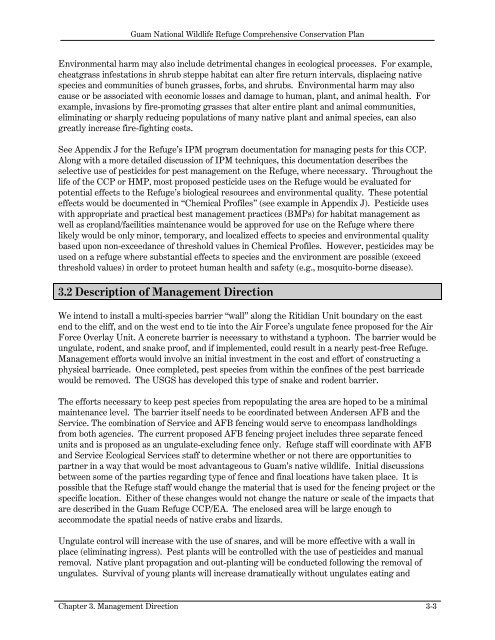Guam National Wildlife Refuge Comprehensive Conservation Plan
Guam National Wildlife Refuge Comprehensive Conservation Plan
Guam National Wildlife Refuge Comprehensive Conservation Plan
You also want an ePaper? Increase the reach of your titles
YUMPU automatically turns print PDFs into web optimized ePapers that Google loves.
<strong>Guam</strong> <strong>National</strong> <strong>Wildlife</strong> <strong>Refuge</strong> <strong>Comprehensive</strong> <strong>Conservation</strong> <strong>Plan</strong><br />
Environmental harm may also include detrimental changes in ecological processes. For example,<br />
cheatgrass infestations in shrub steppe habitat can alter fire return intervals, displacing native<br />
species and communities of bunch grasses, forbs, and shrubs. Environmental harm may also<br />
cause or be associated with economic losses and damage to human, plant, and animal health. For<br />
example, invasions by fire-promoting grasses that alter entire plant and animal communities,<br />
eliminating or sharply reducing populations of many native plant and animal species, can also<br />
greatly increase fire-fighting costs.<br />
See Appendix J for the <strong>Refuge</strong>’s IPM program documentation for managing pests for this CCP.<br />
Along with a more detailed discussion of IPM techniques, this documentation describes the<br />
selective use of pesticides for pest management on the <strong>Refuge</strong>, where necessary. Throughout the<br />
life of the CCP or HMP, most proposed pesticide uses on the <strong>Refuge</strong> would be evaluated for<br />
potential effects to the <strong>Refuge</strong>’s biological resources and environmental quality. These potential<br />
effects would be documented in “Chemical Profiles” (see example in Appendix J). Pesticide uses<br />
with appropriate and practical best management practices (BMPs) for habitat management as<br />
well as cropland/facilities maintenance would be approved for use on the <strong>Refuge</strong> where there<br />
likely would be only minor, temporary, and localized effects to species and environmental quality<br />
based upon non-exceedance of threshold values in Chemical Profiles. However, pesticides may be<br />
used on a refuge where substantial effects to species and the environment are possible (exceed<br />
threshold values) in order to protect human health and safety (e.g., mosquito-borne disease).<br />
3.2 Description of Management Direction<br />
We intend to install a multi-species barrier “wall” along the Ritidian Unit boundary on the east<br />
end to the cliff, and on the west end to tie into the Air Force’s ungulate fence proposed for the Air<br />
Force Overlay Unit. A concrete barrier is necessary to withstand a typhoon. The barrier would be<br />
ungulate, rodent, and snake proof, and if implemented, could result in a nearly pest-free <strong>Refuge</strong>.<br />
Management efforts would involve an initial investment in the cost and effort of constructing a<br />
physical barricade. Once completed, pest species from within the confines of the pest barricade<br />
would be removed. The USGS has developed this type of snake and rodent barrier.<br />
The efforts necessary to keep pest species from repopulating the area are hoped to be a minimal<br />
maintenance level. The barrier itself needs to be coordinated between Andersen AFB and the<br />
Service. The combination of Service and AFB fencing would serve to encompass landholdings<br />
from both agencies. The current proposed AFB fencing project includes three separate fenced<br />
units and is proposed as an ungulate-excluding fence only. <strong>Refuge</strong> staff will coordinate with AFB<br />
and Service Ecological Services staff to determine whether or not there are opportunities to<br />
partner in a way that would be most advantageous to <strong>Guam</strong>’s native wildlife. Initial discussions<br />
between some of the parties regarding type of fence and final locations have taken place. It is<br />
possible that the <strong>Refuge</strong> staff would change the material that is used for the fencing project or the<br />
specific location. Either of these changes would not change the nature or scale of the impacts that<br />
are described in the <strong>Guam</strong> <strong>Refuge</strong> CCP/EA. The enclosed area will be large enough to<br />
accommodate the spatial needs of native crabs and lizards.<br />
Ungulate control will increase with the use of snares, and will be more effective with a wall in<br />
place (eliminating ingress). Pest plants will be controlled with the use of pesticides and manual<br />
removal. Native plant propagation and out-planting will be conducted following the removal of<br />
ungulates. Survival of young plants will increase dramatically without ungulates eating and<br />
Chapter 3. Management Direction 3-3

















